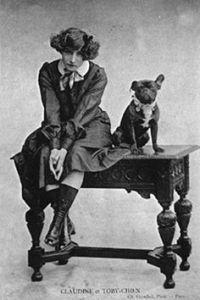Tags
As is clear from the collection of stories La maison de Claudine (1922), the nonhuman world presents a microcosm of creative fecundity for Sidonie-Gabrielle Colette’s semi-autobiographical narrator Claudine.  The text’s description of the natural world is unique—not just for Colette’s time but for our time as well—in its rejection of easy one-for-one metaphors. In other words, when Colette presents a dog, it is just that: a dog, and not a stand-in for a character’s emotions or foreshadowing of future terror. In the story “La Toutouque,” the narrator describes a “large et basse” bulldog her brother rescued from the trenches of World War I. When Toutouque speaks, it is not just as if she speaks:
The text’s description of the natural world is unique—not just for Colette’s time but for our time as well—in its rejection of easy one-for-one metaphors. In other words, when Colette presents a dog, it is just that: a dog, and not a stand-in for a character’s emotions or foreshadowing of future terror. In the story “La Toutouque,” the narrator describes a “large et basse” bulldog her brother rescued from the trenches of World War I. When Toutouque speaks, it is not just as if she speaks:
La reprise énergique—piano solo—entrouvrit les yeux, pleins d’humain égarement, de la Toutouque musicienne, qui se leva et m’interrogea clairement: « Est-ce que je n’ai pas entendu ça quelque part ?… » Puis elle se tourna vers son ingénieux bourreau, qui martelait toujours l’air favori, accepta de lui cette magie nouvelle et vint s’asseoir au flanc du piano, pour écouter mieux, avec l’air entendu et mystifié d’un enfant qui suit une conversation entre grandes personnes. (88)
As a music lover, Toutouque is drawn into wakefulness by the piano solo. It is not that she is transformed by the music so much as she is pulled into the world of the “grandes personnes” through the art. And although Toutouque may have “l’air d’un enfant,” she is not a substitute for an infant. Nor is she removed from her more base animal instincts. At the end of the story, Toutouque attacks another dog and Claudine is shocked at her brutality. She wonders, horrified, what evil has the ability to “changer en brute féroce la plus douce des creatures” (90). Toutouque, while a sweet reminder of Claudine’s childhood, is first and foremost a dog.
Toutouque can offer us some more clues here, particularly in relation to gender and power. As a rescued dog, Toutouque becomes beholden to her rescuer and vacillates—at least according to the narrator—between the pain and pleasure of his attention:
Pour lui, elle devenait sotte, courbait le front et ne savait plus que courir au-devant des tourments qu’elle espérait comme des récompenses. Elle se couchait sur le dos, offrait son ventre, clouté de tétines violacées, sur lesquelles mon frère pianotait, en les pinçant à tour de rôle, l’air du Menuet de Boccherini. Le rite commandait qu’à chaque pinçon la Toutouque jetât–elle n’y manquait point–un petit glapissement, et mon frère s’écriait, sévère: “Toutouque! vous chantez faux! Recommencez!” (87)
Although the narrator tells us that “il n’y mettait aucune cruauté,” one has to wonder. Toutouque receives these torments “comme des récompenses,” but the element of submission seems forced by Toutouque’s status as a rescued animal. With each pinch, Toutouque utters a small “glapissement”—a yelp or squeak—that the narrator casts as a part of a role. The root of the word “glapissement” is the same as the verb “glapir,” which means to shriek but also to bark. In this word, Toutouque’s status as an animal and a victim are entangled. This “rite” demonstrates the man’s dominance in an elaborate performance the woman/animal enters into willingly. In a strange twist, the dominator goes so far as to characterize the cries Toutouque emits as out of tune, insisting that she begin again. The rite, it seems, is without end.
